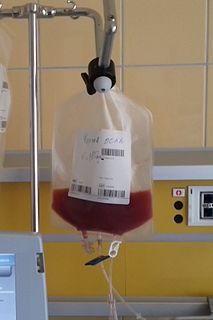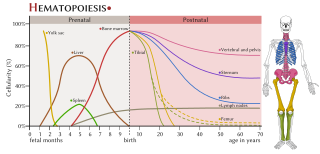Related Research Articles

Bone marrow is a semi-solid tissue found within the spongy portions of bones. In birds and mammals, bone marrow is the primary site of new blood cell production. It is composed of hematopoietic cells, marrow adipose tissue, and supportive stromal cells. In adult humans, bone marrow is primarily located in the ribs, vertebrae, sternum, and bones of the pelvis. Bone marrow comprises approximately 5% of total body mass in healthy adult humans, such that a man weighing 73 kg (161 lbs) will have around 3.7 kg (8 lbs) of bone marrow.
Anti-thymocyte globulin (ATG) is an infusion of horse or rabbit-derived antibodies against human T cells and their precursors (thymocytes), which is used in the prevention and treatment of acute rejection in organ transplantation and therapy of aplastic anemia.

Hematopoietic stem-cell transplantation (HSCT) is the transplantation of multipotent hematopoietic stem cells, usually derived from bone marrow, peripheral blood, or umbilical cord blood in order to replicate inside of a patient and to produce additional normal blood cells. It may be autologous, allogeneic or syngeneic.
Allotransplant is the transplantation of cells, tissues, or organs to a recipient from a genetically non-identical donor of the same species. The transplant is called an allograft, allogeneic transplant, or homograft. Most human tissue and organ transplants are allografts.
A cord blood bank is a facility which stores umbilical cord blood for future use. Both private and public cord blood banks have developed in response to the potential for cord blood in treating diseases of the blood and immune systems. Public cord blood banks accept donations to be used for anyone in need, and as such function like public blood banks. Traditionally, public cord blood banking has been more widely accepted by the medical community. Private cord blood banks store cord blood solely for potential use by the donor or donor's family. Private banks typically charge around $2,000 for the collection and around $200 a year for storage.

Hematopoietic stem cells (HSCs) are the stem cells that give rise to other blood cells. This process is called haematopoiesis. In vertebrates, the very first definitive HSCs arise from the ventral endothelial wall of the embryonic aorta within the (midgestational) aorta-gonad-mesonephros region, through a process known as endothelial-to-hematopoietic transition. In adults, haematopoiesis occurs in the red bone marrow, in the core of most bones. The red bone marrow is derived from the layer of the embryo called the mesoderm.

Cell therapy is a therapy in which viable cells are injected, grafted or implanted into a patient in order to effectuate a medicinal effect, for example, by transplanting T-cells capable of fighting cancer cells via cell-mediated immunity in the course of immunotherapy, or grafting stem cells to regenerate diseased tissues.
Cord blood is blood that remains in the placenta and in the attached umbilical cord after childbirth. Cord blood is collected because it contains stem cells, which can be used to treat hematopoietic and genetic disorders such as cancer. There is growing interest from cell therapeutics companies in developing genetically modified allogenic natural killer cells from umbilical cord blood as an alternative to CAR T cell therapies for rare diseases.
Autotransplantation is the transplantation of organs, tissues, or even particular proteins from one part of the body to another in the same person.
Palifermin is a truncated human recombinant keratinocyte growth factor (KGF) produced in Escherichia coli. KGF stimulates the growth of cells that line the surface of the mouth and intestinal tract.
In medicine, photopheresis is a form of apheresis and photodynamic therapy in which blood is subject to apheresis to separate buffy coat from whole blood, chemically treated with 8-methoxypsoralen, exposed to ultraviolet light (UVA), and then returned to the patient. Activated 8-methoxypsoralen crosslinks DNA in exposed cells, ultimately resulting apoptosis of nucleated cells. The photochemically damaged T-cells returned to the patient appear to induce cytotoxic effects on T-cell formation. The mechanism of such “antitumor” action has not been elucidated.
The National Marrow Donor Program (NMDP) is a nonprofit organization founded in 1986 and based in Minneapolis, Minnesota, that operates the Be The Match Registry of volunteer hematopoietic cell donors and umbilical cord blood units in the United States.

Acute myeloblastic leukemia without maturation is a quickly progressing disease in which too many immature white blood cells are found in the blood and bone marrow.

Atiprimod is a substance being studied in the treatment of certain multiple myelomas and other advanced cancers. It may block the growth of tumors and the growth of blood vessels from surrounding tissue to the tumor. This drug is also being researched as a potential treatment for various autoimmune diseases. It was first developed by GlaxoSmithKline as a potential treatment for rheumatoid arthritis. The substance is also known as azaspirane, although this more properly refers to the class of chemicals to which atiprimod belongs.
Autologous stem-cell transplantation is autologous transplantation of stem cells—that is, transplantation in which stem cells are removed from a person, stored, and later given back to that same person.

Treosulfan, sold under the brand name Trecondi, is a medication given to people before they have a bone marrow transplant from a donor known as allogeneic hematopoietic stem cell transplantation. It is used as a 'conditioning' treatment to clear the bone marrow and make room for the transplanted bone marrow cells, which can then produce healthy blood cells. It is used together with another medicine called fludarabine in adults and children from one month of age with blood cancers as well as in adults with other severe disorders requiring a bone marrow transplant.
Idiopathic pneumonia syndrome is a set of pneumonia-like symptoms that occur with no sign of infection in the lung. Idiopathic pneumonia syndrome is a serious condition that can occur after a stem cell transplant. It occurs between 2.2 and 15 percent of hematopoietic stem cell transplants. The incubation period ranges between 4 and 106 days, but mostly is about 22 days from transplant.

Peripheral blood stem cell transplantation (PBSCT), also called "Peripheral stem cell support", is a method of replacing blood-forming stem cells. Stem cells can be destroyed through cancer treatments such as chemotherapy or radiation, as well as any blood-related diseases, such as leukemia, lymphoma, neuroblastoma and multiple myeloma. PBSCT is now a much more common procedure than its bone marrow harvest equivalent due to the ease and less invasive nature of the procedure. Studies suggest that PBSCT has a better outcome in terms of the number of hematopoietic stem cell yield.

The haematopoietic system is the system in the body involved in the creation of the cells of blood.
Stromagen is a product that is made of stem cells taken from a patient's bone marrow and grown in the laboratory. After a patient's bone marrow is destroyed by treatment with whole body irradiation or chemotherapy, these cells are injected back into the patient to help rebuild bone marrow. Stromagen has been studied in the prevention of graft-versus-host disease during stem cell transplant in patients receiving treatment for cancer. Stromagen is used in cellular therapy. Also called autologous expanded mesenchymal stem cells OTI-010. Peripheral stem cell transplantation may allow doctors to give higher doses of chemotherapy and kill more tumor cells. It is not yet known whether Stromagen improves the success of stem cell transplantation in women with breast cancer.
References
- Syngeneic stem cell transplantation entry in the public domain NCI Dictionary of Cancer Terms
![]() This article incorporates public domain material from the U.S. National Cancer Institute document: "Dictionary of Cancer Terms".
This article incorporates public domain material from the U.S. National Cancer Institute document: "Dictionary of Cancer Terms".